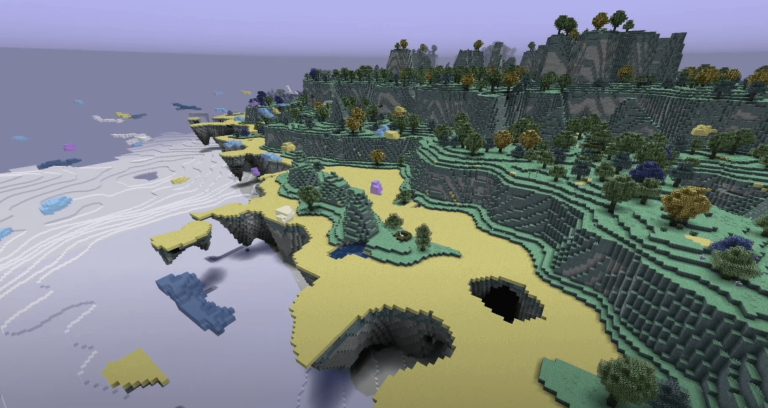Nothing has surprised the gaming world more than the rise of Minecraft. The simple gameplay and easy creative tools have meant that Minecraft has amassed more than 141 million active players – both young and old. In addition to creative building, one of the funnest elements of the game are Minecraft weapons and armor. In this comprehensive guide, we’ll delve into the fascinating world of Minecraft weaponry and protective gear, equipping you with the knowledge and strategies to conquer the blocky realm like a pro.
At CodaKid, we are masters at creating modded weapons and armor in Minecraft using pixel art tools and Java programming. This blog will primarily cover standard weapons in the Minecraft game, but we will also get your creative juices flowing with some modded weapon ideas and some cool images of ones that we’ve created. If you’d like to learn more about how to create your own customMinecraft weapons and armor check out our Minecraft coding page where you can sign up for free.
Table of Contents
Brief Overview of the Importance of Weapons and Armor in Minecraft
In the pixelated world of Minecraft, survival hinges on your ability to harness the power of tools, weapons, and armor. Weapons serve as your trusty companions, allowing you to fend off the relentless onslaught of mobs or rival players with hostile intentions. With a formidable arsenal in hand, you can not only protect yourself but also harvest valuable materials and coveted items from defeated adversaries.
Yet, weaponry alone isn’t enough to ensure your survival. Armor, an essential component of your Minecraft journey, shields you from the formidable threats lurking in the game’s vast landscapes.
Without adequate armor, your time in Minecraft could be perilously short-lived, as you’ll find yourself vulnerable to the relentless challenges presented by the game’s unforgiving world. In this guide, we’ll delve deeper into the world of Minecraft weapons and armor, uncovering the strategies and knowledge that will empower you to thrive amidst the blocky perils.
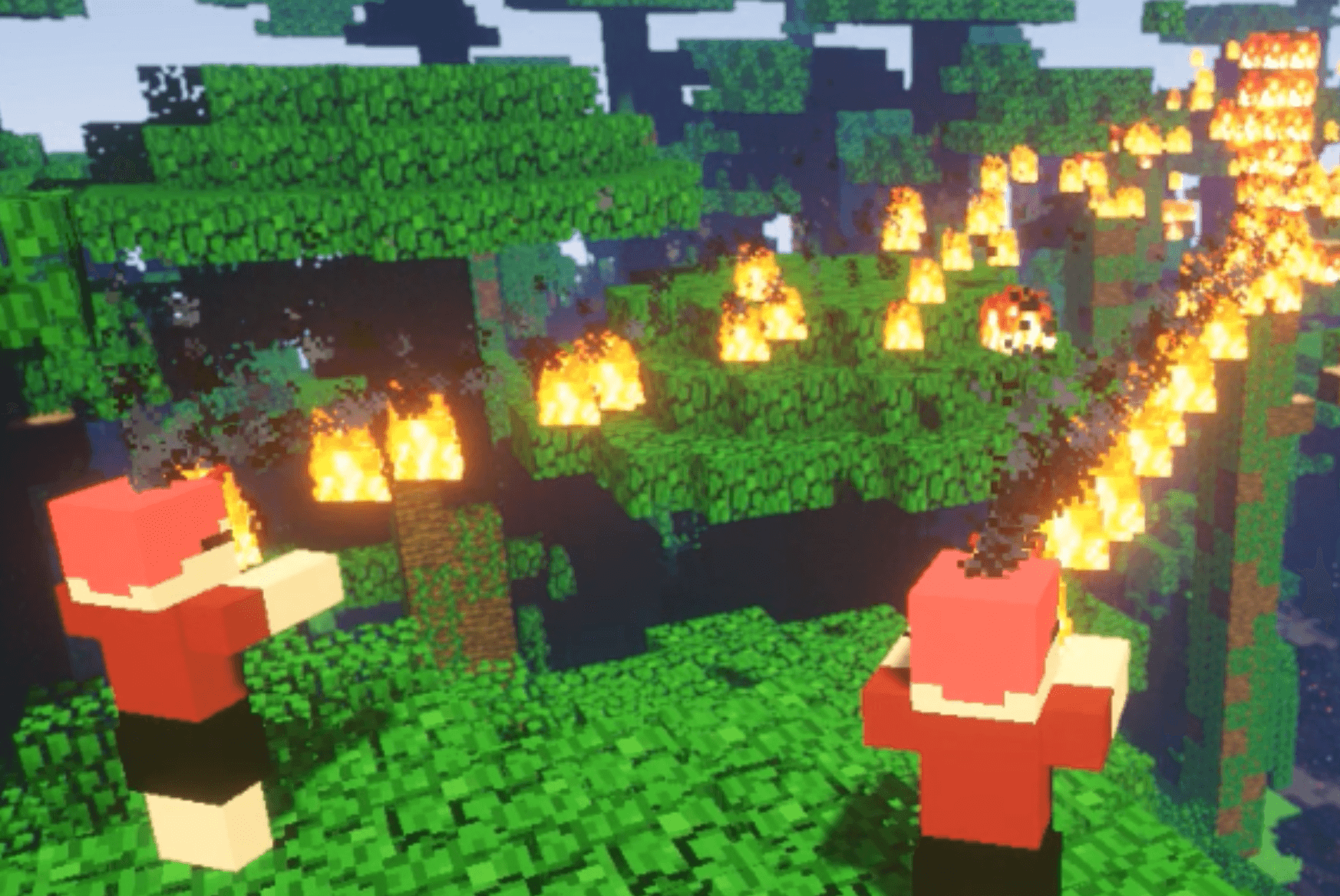
The Evolving Nature of Minecraft
In a gaming world characterized by fleeting trends, Minecraft remains an enduring phenomenon. Surpassing 238 million copies sold, it has cemented its place by offering limitless creative and exploratory potential.
Minecraft’s continual transformation is a tribute to its creators’ vision and their commitment to an adaptable gaming experience. With each update, whether introducing innovative mechanics, aesthetic improvements, or even the allure of commands and cheats, Minecraft’s universe expands, delivering deeper immersion and boundless horizons.
Today, Minecraft’s evolution continues, as can be seen by updates such as Caves & Cliffs. These ongoing enhancements, often accompanied by new commands and cheats, invite players to unearth fresh challenges, resources, and terrains, ensuring that the Minecraft world never stops evolving.
Minecraft Weapons
Weapons in Minecraft are more than just tools; they’re your ultimate defense against the myriad threats lurking within the game’s blocky landscapes. These specialized items are engineered to significantly damage mobs, enabling you to eliminate them, secure their valuable loot, and safeguard your survival.
Minecraft offers a diverse array of weapons, from swords and bows to enchanted implements. Some are designed for up-close and personal combat, while others allow you to strike from a distance. Among the arsenal of weaponry, tridents stand as a hybrid marvel, capable of ranged and melee attacks.
Yet, the utility of these weapons extends beyond their primary function. In this article, we’ll explore some creative and unconventional ways to wield Minecraft weapons, unlocking their potential for unique applications within the game.
Melee Weapons
In Minecraft, melee weapons add a punch to your combat strategy, allowing you to deal extra damage with each swing, albeit with a slightly longer attack time than your fists. Among these close-quarters contenders, swords reign supreme, offering the highest damage per second in the game.
With a swift cooldown of 0.6 seconds, swords outpace their axe-wielding counterparts by 60%. Their unique sweep attack ability also lets you hit multiple targets, making them a formidable choice. Notably, swords stand second in damage only to tridents among all melee weapons in the Bedrock Edition.
Swords
Not only do swords serve as your primary weapon against hostile mobs, but they also excel in hastening the excavation of specific blocks like cobwebs. While other tools may inflict damage, the sword outshines them, dealing superior harm without incurring the double durability penalty, making it an indispensable asset in your Minecraft arsenal.

Types of Swords and their Attributes
In Minecraft, acquiring the sword of your choice is a crafty endeavor. Nearly all these blades can be obtained through crafting, demanding only a stick and two units of the corresponding material – planks, cobblestone, iron ingots, gold ingots, or diamonds. In your crafting window, simply place the stick in the middle slot of the bottom row, flanked by the chosen blocks or ingots.
And, the Netherite sword reigns supreme, delivering the highest lifetime damage dealt among all these formidable blades. Choose your sword wisely and master the art of combat in the world of Minecraft.
- Wooden Sword: The weakest sword, dealing 4 attack damage.
- Stone Sword: Slightly stronger than wood, dealing 5 attack damage.
- Iron Sword: More durable and powerful, dealing 6 attack damage.
- Golden Sword: The weakest among metal swords, dealing 4 attack damage but has low durability.
- Diamond Sword: The most potent non-enchanted sword, dealing 7 attack damage.
- Netherite Sword: Comparable to diamond swords, but with increased durability and the ability to float in lava.
- Enchanted Swords: Swords with enchantments like Sharpness, Bane of Arthropods, Smite, and Fire Aspect for added abilities.
- Cursed Swords: Such as the Cursed Sword or Sword of Decay, which inflicts negative status effects on targets.
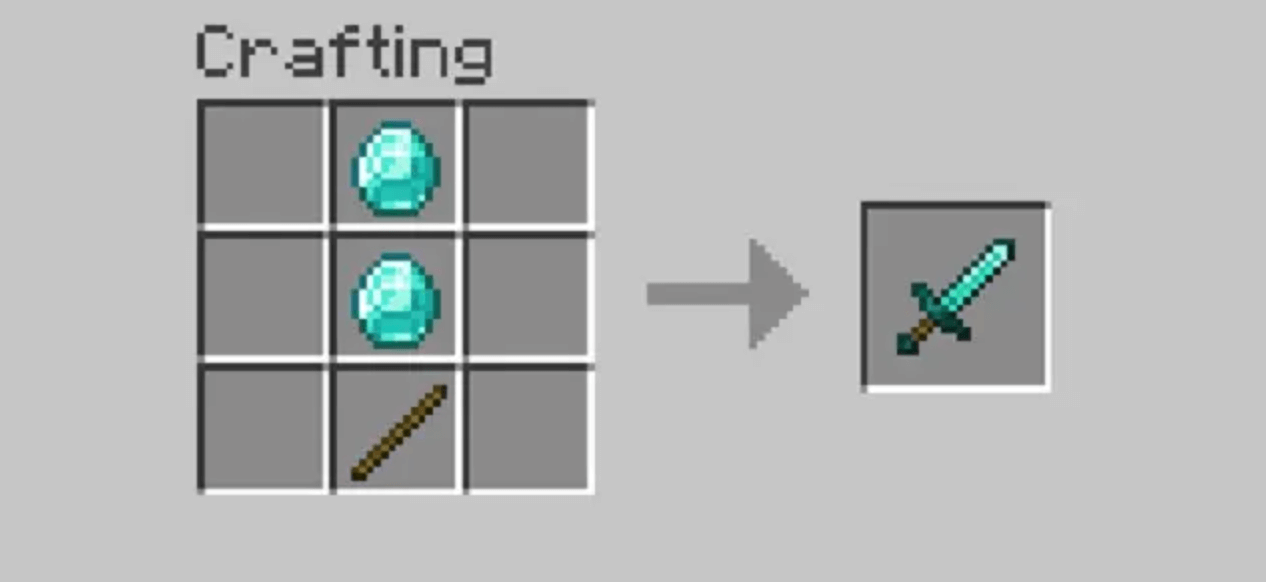
Crafting Recipes
Weapons are your trusty companions in the battle against mobs in Minecraft. You can craft melee weapons like swords, tridents, bows, crossbows, and arrows. For instance, you’ll require one stick and two diamonds to craft a mighty diamond sword.
Alternatively, gather sticks and an assortment of wood planks for a wooden sword. Simply access the crafting table, and by following the outlined steps in the crafting menu, you’ll forge the weaponry needed for your Minecraft adventures.
Recommended Enchantments
Enchantments are game-changers, offering a substantial advantage in solo survival or intense PvP battles. Each enchantment functions uniquely, and items can be enchanted at different levels, typically ranging from 1 to 5, with higher levels yielding more potent effects.
Consider enchantments such as:
- Bane of Arthropods: Deals extended damage to arthropod mobs like spiders, cave spiders, and more.
- Smite: Increases damage inflicted upon undead mobs, including skeletons, zombies, and more.
- Knockback: Knocks mobs back a few blocks upon hitting them, useful for crowd control but can be a nuisance with ranged mobs.
- Mending: Repairs durability in exchange for experience points gained from kills.
- Fire Aspect: Sets the target on fire, dealing continuous damage.
- Sweeping Edge: Increases sweep attack damage for crowd control.
- Unbreaking: Extends item durability and reduces the chance of durability loss with use.
- Looting: Increases loot drops from mobs, allowing for more rare and valuable drops.
- Sharpness: Increases melee damage against all mobs, with Sharpness 5 being particularly powerful.
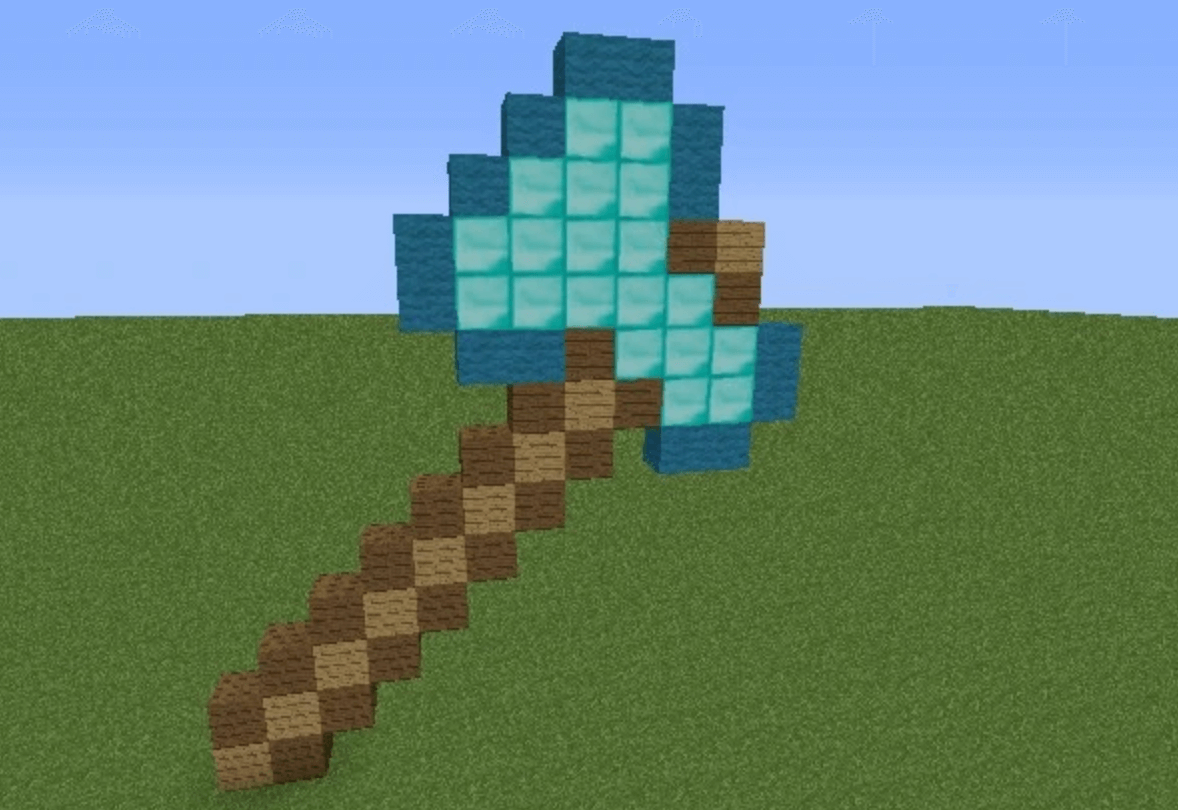
Axes
The Axe in Minecraft is a versatile tool, primarily used for swiftly chopping down trees or dismantling various wooden items. Gold axes are the quickest but least durable, crafted from Wood, Cobblestone, Iron Ingots, Gold Ingots, or Diamonds. Axes have gained traction for their unique ability to disable shields in PvP combat, making them a formidable choice.
Axe Differences from Swords
Axes stand out from swords due to their potential for quicker kills, often taking down an enemy in a single blow compared to the 2 or 3 hits required by swords. Speedrunners favor axes for their increased damage output, although in prolonged gameplay, they can be less efficient due to their two-durability reduction per hit.
Axe Crafting Recipes
Crafting an axe requires 2 sticks and 3 blocks of axe type (Wooden, Stone, Iron, Gold, or Diamond). Sticks are vital crafting materials, crucial in various items across the game.
Best Use Cases
Axes excel in woodcutting and can double as formidable weapons. The wooden axe, for example, deals the same damage as a diamond sword, hinting at the potential for devastating power with an iron axe enchanted with Sharpness. However, Bedrock Edition players should favor swords for combat, as axes deal less damage in this version.
![]()
Ranged Weapons
Ranged weapons bring a new dimension to combat, with Power, Speed, and Ammo stats setting them apart from their melee counterparts, which rely on Area stats instead of Ammo. While certain weapon attributes like Damage and Enchantments may vary, Power, Speed, and Ammo remain consistent across weapon versions.
Many players tend to focus on the best-enchanted swords for combat, often overlooking the immense potential of ranged weapons with the right enchantments. The game features two primary ranged options: the trusty Bow and the formidable Crossbow, the latter dealing higher damage and introducing new enchantment possibilities.
And don’t forget the Trident, primarily a melee weapon but equipped with ranged capabilities through enchantments, making it a versatile addition to your Minecraft arsenal.
Bows
As far as ranged weaponry in Minecragt goes, the bow reigns supreme. This versatile tool hurls arrows at your target with precision. Drawing a bow requires at least one arrow in your inventory or Creative mode. The bow’s display slightly zooms in as it’s drawn, with a visible shake when fully charged.
Releasing the button unleashes the arrow. You can cancel the draw by switching to another hotbar slot. Remember that charging a bow slows your movement, preventing sprinting and sneaking further reduces your speed during the draw.
Crafting and Upgrading Bows
Crafting a bow in Minecraft is a straightforward process, ideal for early-game survival. Gather three strings and three sticks, readily found in the game world. Head to a crafting table, use the specified recipe, and retrieve your brand-new bow from the crafting slot.
To enhance your bow’s power, enchant it using an enchanting table, anvil, or game command. Enchantments can be a game-changer, turning a basic bow into a formidable weapon with unique abilities.
Arrows and Their Types
In Minecraft, crafting normal arrows is a fundamental skill. These arrows are created using one flint, one stick, and one feather. They serve as your primary ammunition for bows, making them a must-have for ranged combat and hunting. On the other hand, spectral arrows are a specialized type of ammunition.
Crafting them requires four glowstone dust and one regular arrow. These unique arrows have the ability to illuminate targeted entities, making them highly useful in low-light situations, especially when tracking or engaging foes in the dark corners of the Minecraft world. There are tipped arrows today, but more to come on that later.
Tips for Accurate Shooting
Improving shooting accuracy with your bow in Minecraft requires practice and precision. Master the timing of your shots, learn to gauge distances, and consider using enchantments like “Infinity” and “Power” to enhance your accuracy and damage.
Crossbows
Crossbows in Minecraft function like bows but offer distinct advantages. While they take longer to load, they pack more power, ensuring arrows travel farther and with greater accuracy. Crossbows even allow you to load firework rockets for unique effects.
In terms of raw power, crossbows surpass bows, dealing between 6 and 11 attack damage, compared to bows which deal 1–10 attack damage. However, bows have a quicker recharge time, making them a better choice in certain situations.
Crafting and Using Crossbows
Creating a crossbow requires one iron ingot, three sticks, two strings, and one tripwire hook. In the crafting table, arrange these materials as follows:
- First row: 1 stick, 1 iron ingot, 1 stick
- Second row: 1 string, 1 tripwire hook, 1 string
- Third row: 1 stick (in the middle)
To load a crossbow, hold it and hit the use button, taking slightly over a second. Once loaded, fire with another click of the use button, dealing an average of nine points of damage.
Unique Abilities
Crossbows offer distinct advantages in Minecraft. Unlike traditional bows, crossbows don’t demand the same physical strength or rapid aiming skills. They possess greater power, dealing eleven points of damage and reaching targets up to twenty blocks away, making them formidable long-range weapons.
Comparison with Bows
Bows and crossbows serve as indispensable long-range weapons in Minecraft, enabling players to engage creatures from a safe distance, preventing melee damage. Crossbows hold the edge in terms of damage, dealing between 6 and 11 attack damage, while bows offer 1 to 10.
Bows are quicker to reload at 1.1 seconds, while crossbows take 1.25 seconds, potentially impacting survival. Crossbows also boast a superior range, covering 100 meters compared to bows’ 50 meters, and have greater durability, with 465 compared to bows’ 385, ensuring longevity and toughness.

Special Weapons
In the vast and dynamic world of Minecraft, a range of special weapons awaits the intrepid adventurer. Beyond the conventional tools, these unique armaments wield extraordinary powers, offering new dimensions of gameplay and strategies for overcoming the challenges that lie ahead.
Tridents
Tridents in Minecraft are versatile weapons, unique in their ability to excel both in melee and ranged combat. Acquired as rare drops from drowned mobs, tridents offer two distinct methods of dealing damage to foes, making them a valuable addition to any adventurer’s arsenal.
When thrown, the trident requires holding down the attack button, triggering a charging animation akin to the bow.
Acquisition and Rarity
Tridents are prized weapons in Minecraft, but their rarity matches their value. You can’t craft them; but you can achieve them through combat and elimination, pilfering, bartering, and command usage. Further, inn Bedrock Edition, drowned have a 15% chance of spawning with a Trident (6.25% in Java Edition), and they themselves have an 8.5% chance of dropping it upon death.
Note that Tridents thrown by drowned can’t be picked up, like Skeletons’ fired arrows. Tridents stand out as both melee and ranged weapons. While their melee attack resembles a sword, it’s slightly slower in Java Edition with a brief pause after each swing. The ranged attack requires holding the Use Button and follows a ballistic arc, similar to arrows and snowballs, requiring precise aiming to compensate for the drop.
Unique Abilities
Tridents in Minecraft boast both common enchantments like unbreaking, mending, and curse of vanishing, alongside four exclusive enchantments. “Loyalty” makes a thrown trident return to the player, while “Impaling” inflicts extra damage on aquatic and wet-condition mobs. “Riptide” propels the player and deals splash damage when thrown in wet conditions.
During a thunderstorm, the “channeling” enchantment summons a lightning bolt upon hitting a mob, bestowing a godly touch of thunder on the wielder. These enchantments make tridents remarkable tools in the Minecraft arsenal.
Combat Strategies
In combat, a trident in Minecraft offers unique advantages. Its ranged capabilities provide a tactical edge, especially with enchantments like “Channeling” during thunderstorms. Additionally, “Impaling” increases damage against aquatic foes, making it a versatile weapon.
Tipped Arrows
Tipped arrows in Minecraft are special ammunition created by applying potions to regular arrows in a brewing stand. These arrows inherit the effects of the potion and can deliver status effects to mobs or players upon impact.
15 different tipped arrows can be made with various potions, including:
- Arrow of Regeneration
- Arrow of Swiftness
- Arrow of Fire Resistance
- Arrow of Healing
- Arrow of Night Vision
- Arrow of Strength
- Arrow of Leaping
- Arrow of Invisibility
- Arrow of Poison
- Arrow of Weakness
- Arrow of Slowness
- Arrow of Harming
- Arrow of Water Breathing
- Arrow of the Turtle Master
- Arrow of Slow Falling
Crafting and Using Tipped Arrows
Crafting tipped arrows in Minecraft involves surrounding a potion bottle with regular arrows on a crafting table. This transforms the arrows into eight tipped ones, each carrying the chosen potion effect. Alternatively, using water bottles instead of potion bottles yields tipped arrows with no effect. However, these arrows don’t stack, making them less favored by players.
Effects and Their Application
Tipped arrows serve to apply the status effect of the potion they were dipped in to mobs or players upon impact. These effects endure for 1/8th of the original potion’s duration. Players select the tipped arrow from their hotbar, not the bow, offering precise control when using multiple variants. With Update 1.1, players can place tipped arrows in the off-hand slot for convenient access.
Creative Combat Tactics
Creative combat tactics with tipped arrows involve exploiting their status effects strategically. Poison-tipped arrows can weaken foes over time, while instant damage arrows deliver swift strikes. You can employ invisibility arrows to slip past enemies unnoticed or use slow-falling arrows to control your descent during aerial battles, making these versatile projectiles a key asset in your combat repertoire.
In-depth showcase of weapon types and strategies
Minecraft offers a diverse arsenal of weapons, each with its unique characteristics and strategies. Here, we delve into the specifics of using various weapons effectively in the game.
Swords and Melee Combat
Swords are go-to weapons for melee combat. The key is timing your strikes; spam-clicking reduces damage output. Learn to time your attacks to maximize damage and conserve durability. Enchantments like “Sharpness” and “Smite” boost your sword’s potency, while “Looting” increases loot drop rates.
Bows and Ranged Precision
Bows are your ranged weapon of choice. Draw the bowstring back fully for maximum damage and range. Leading targets correctly is vital for hitting moving mobs. Enchantments like “Power” enhance damage, and “Infinity” ensures your quiver never runs dry. Always carry a bundle of arrows for sustained ranged combat.
Crossbows
Crossbows, more powerful than bows, require a longer reload time. However, they offer a unique ability to load various projectiles, including fireworks for added spectacle. “Quick Charge” shortens reload times, while “Piercing” allows shots to pass through multiple targets. Use crossbows strategically to take down enemies with precision.
Tridents and Versatile Warfare
Tridents are both melee and ranged weapons. Learn to wield them effectively in both scenarios. Use “Loyalty” to retrieve thrown tridents and “Impaling” for extra aquatic mob damage. Remember, they can be thrown during rain or underwater for added mobility and damage.
Tipped Arrows and Status Effects
Tipped arrows offer an array of status effects. Poison, harming, invisibility, and slow-falling are just a few. Strategically use them to weaken foes, surprise enemies with invisibility, or control your descent in aerial battles. Remember that the potion’s duration is reduced to 1/8th when applied to arrows.
Unique Enchantments
Weapon enchantments like “Unbreaking,” “Mending,” and “Curse of Vanishing” enhance durability, longevity, and unique qualities. Experiment with these enchantments to tailor your weapons to your playstyle.
Minecraft Armor
Survival often hinges on more than just your weaponry; armor plays a crucial role in safeguarding your journey through its diverse landscapes. Minecraft offers a range of armor types, each with its unique attributes and protection levels. Here, we explore the intricacies of Minecraft armor and offer strategies for maximizing its utility.
Basic Armor Types
Minecraft features four basic armor types: leather, chainmail, iron, and diamond. Leather armor, the most readily available, offers basic protection but lacks durability. Chainmail armor is rare, typically obtained through trading or mob drops, providing moderate protection. Iron armor, crafted from iron ingots, offers solid defense, while diamond armor stands as the pinnacle of protection with superior durability.
Special Armor
In addition to the basic types, Minecraft introduces special armor sets like Netherite, which is an upgrade for diamond armor. Netherite armor boasts increased durability and better resistance to fire damage.
Armor Points
Armor in Minecraft functions by providing Armor Points (or simply “armor”) to mitigate damage. These points absorb a portion of incoming damage, reducing its impact on your health bar. The more points you have, the better your protection. For optimal defense, aim for a full set of armor, including a helmet, chestplate, leggings, and boots.
Enchantments and Enhancements
Enchanting your armor can significantly boost its effectiveness. “Protection” reduces all types of damage, while “Projectile Protection” focuses on ranged attacks. “Blast Protection” mitigates explosion damage, and “Fire Protection” guards against flames. Customize your armor based on your intended challenges and threats.
Strategy and Maintenance
Strategically maintaining and upgrading your armor is crucial for long-term survival. Enchant armor pieces with “Unbreaking” to extend their lifespan and “Mending” to repair them with XP orbs. Crafting and upgrading to Netherite armor can further enhance your protection.
Armor Sets
Armor sets, mostly available through crafting, complete your defensive attire with four essential components: helmet, chestplate, leggings, and boots, all crafted similarly. Exceptions exist, including an incomplete set, an uncraftable set, and the unique Netherite armor set, acquired through alternative means.
Many armor sets can also be discovered while exploring the diverse structures and dungeons scattered throughout the game.
Leather Armor
Leather armor may offer the lowest armor rating among all types, but it’s a cost-effective early-game choice. Slaying cows for leather, especially if they’re nearby, provides quick access to this armor. Its versatility shines in its dyeability, allowing players to personalize it with any color.
Additionally, leather armor frequently appears as loot in Minecraft, making it accessible in various ways. To save leather for enchantment setups, consider scavenging shipwrecks and ocean ruins, which are prime spots for finding leather armor.
Leather Armor – Basics and Crafting
To assemble a complete set of leather armor, you’ll require a total of 24 leather units. Specifically, you’ll need eight pieces for the tunic, five for the helmet, seven for the leggings, and four for the boots. The crafting process involves placing each leather piece into the crafting table and retrieving the finished item from the right side.
Leather Armor – Limited Protection but Customization
Leather armor provides modest protection but stands out with its customization options, as it can be dyed with various colors to suit your personal style.
Iron Armor
Introduced in Update 0.6.0, Iron Armor ranks among the toughest and most enduring protective gear in Minecraft, second only to Diamond Armor. In your quest for this formidable defense, you may encounter mobs donning chainmail armor.
By tossing iron armor on the ground nearby, you can prompt them to discard the chainmail. Alternatively, seek out loot in village blacksmith houses, where a special chest occasionally contains iron armor and tools, or explore Strongholds and End Cities for more iron armor pieces.
Iron Armor – Durability and Crafting
Iron armor is a practical and widely-used choice in Minecraft, serving as an intermediate set just before acquiring the coveted diamond armor. Crafted from readily available iron ingots, this armor offers respectable protection. Iron ore is commonly found in caves, especially between levels 63 and 1 in the 1.17 update (though ore generation changes in 1.18).
Gathering 24 iron pieces is relatively easy once you have a mine established. With a stone pickaxe, mine the iron ore, then smelt it in a furnace. Crafting the armor uses the same recipes as gold or diamond variants, just with the respective materials. For a helmet, create a row of three iron ingots with two below the edges.
Craft a chestplate by filling every slot except the top middle one with iron. Make leggings by placing two columns of three iron ingots on the sides and one in the top middle slot. Complete the set with boots by arranging four iron ingots in pairs with space between them.
Common Choice for Early-Game Players
Iron armor is a popular pick for early-game Minecraft players due to its availability and effectiveness. It provides a valuable protective barrier against hostile mobs and environmental hazards without the rarity of diamond. Easily acquired through mining iron ore, this armor offers a cost-efficient means of fortifying oneself in the game’s challenging initial phases.
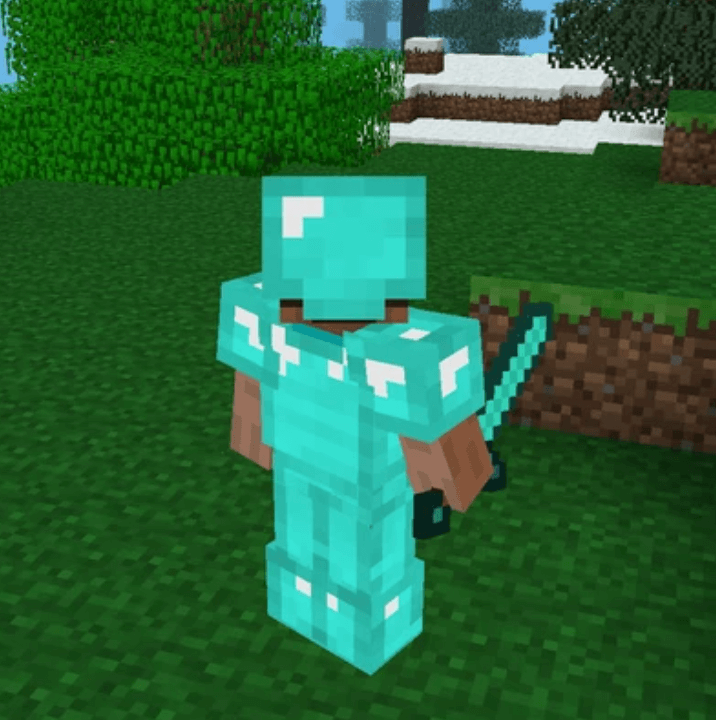
Diamond Armor
Diamond armor is the pinnacle of protection, surpassing all other armor types, including leather, gold, chain, and iron armor, in terms of strength. However, this exceptional defense comes at a cost, as it requires diamonds for crafting. A full set of diamond armor necessitates 24 precious diamonds. Rarely, zombies may spawn wearing complete diamond armor, and on Hard Difficulty, enchantments can occasionally enhance this formidable protection.
Diamond Armor – Superior Protection
In Minecraft, the durability of diamond items and armor far surpasses their softer gold counterparts. While gold weapons and armor may not match the strength of diamond, they compensate with swift block-breaking speed.
Diamond remains the premier choice for crafting tools and equipment, boasting exceptional durability, high protective value in armor, and the ability of pickaxes to easily mine formidable blocks like obsidian. In comparison, gold tools and armor prove less robust and practical. Netherite armor, an upgrade from diamond, offers even greater toughness, with three points compared to diamond’s two, making it more resilient against powerful attacks.
Diamond Armor – Crafting and Enchantments
Diamond Armor is the apex of protection, exceeding leather, gold, chain, and iron armor, although its crafting demands a substantial investment of 24 diamonds. Durability is a vital factor in determining how well your armor can withstand mob attacks in Minecraft. Each piece of diamond armor has its own durability value, as detailed in the table below. To craft diamond armor, you’ll need diamond ore, which can be found by mining below level 15.
For instance, crafting a diamond helmet requires five pieces of diamond ore, offering +3 armor and +2 armor toughness for head protection. An eight-piece diamond chestplate grants +8 armor and +2 armor toughness to shield the upper body. Diamond leggings, made with seven pieces, provide +6 armor and +2 armor toughness for the lower body, while crafting diamond boots from four pieces grants +3 armor and +2 armor toughness for foot protection.
- Diamond Helmet: 363 durability
- Diamond Chest Plate: 528 durability
- Diamond Leggings: 495 durability
- Diamond Boots: 429 durability
Enchanting your diamond chestplate enhances its effectiveness. By combining three lapis lazulis and one diamond chestplate, you can create an enchanted version. Several enchantments are available, each with distinct benefits:
- Blast Protection
- Curse of Binding
- Curse of Vanishing
- Fire Protection
- Mending
- Projectile Protection
- Protection
- Thorns
- Unbreaking
These enchantments offer unique advantages and can be tailored to your specific needs, making your diamond armor even more formidable.
End-Game Favorite
Minecraft is renowned for its sandbox nature, offering players the freedom to shape their own adventures and experiences. It’s often referred to as a “sandbox game” because of its open-ended nature, where creativity knows no bounds, and there are endless ways to play. Players can build, explore, mine, and more, crafting their unique journeys.
While there’s no official endpoint to Minecraft, many consider the game “completed” when they defeat the Ender Dragon, one of the game’s primary challenges. To achieve this, players must follow a series of steps:
- Gather Resources: Players need to prepare extensively by collecting resources, such as diamonds, obsidian, and ender pearls.
- Activate the End Portal: Using ender pearls and blaze powder, players must activate the End Portal found in strongholds.
- Enter the End: Once the portal is activated, players enter the End dimension, where the Ender Dragon resides.
- Defeat the Ender Dragon: Armed with armor, weapons, and tactics, players must battle and defeat the formidable Ender Dragon.
- Collect the Dragon Egg: After victory, players can claim the dragon egg as a trophy.
While defeating the Ender Dragon is considered a major achievement, Minecraft’s open world continues to offer endless adventures and challenges, ensuring that the sandbox adventure never truly ends.
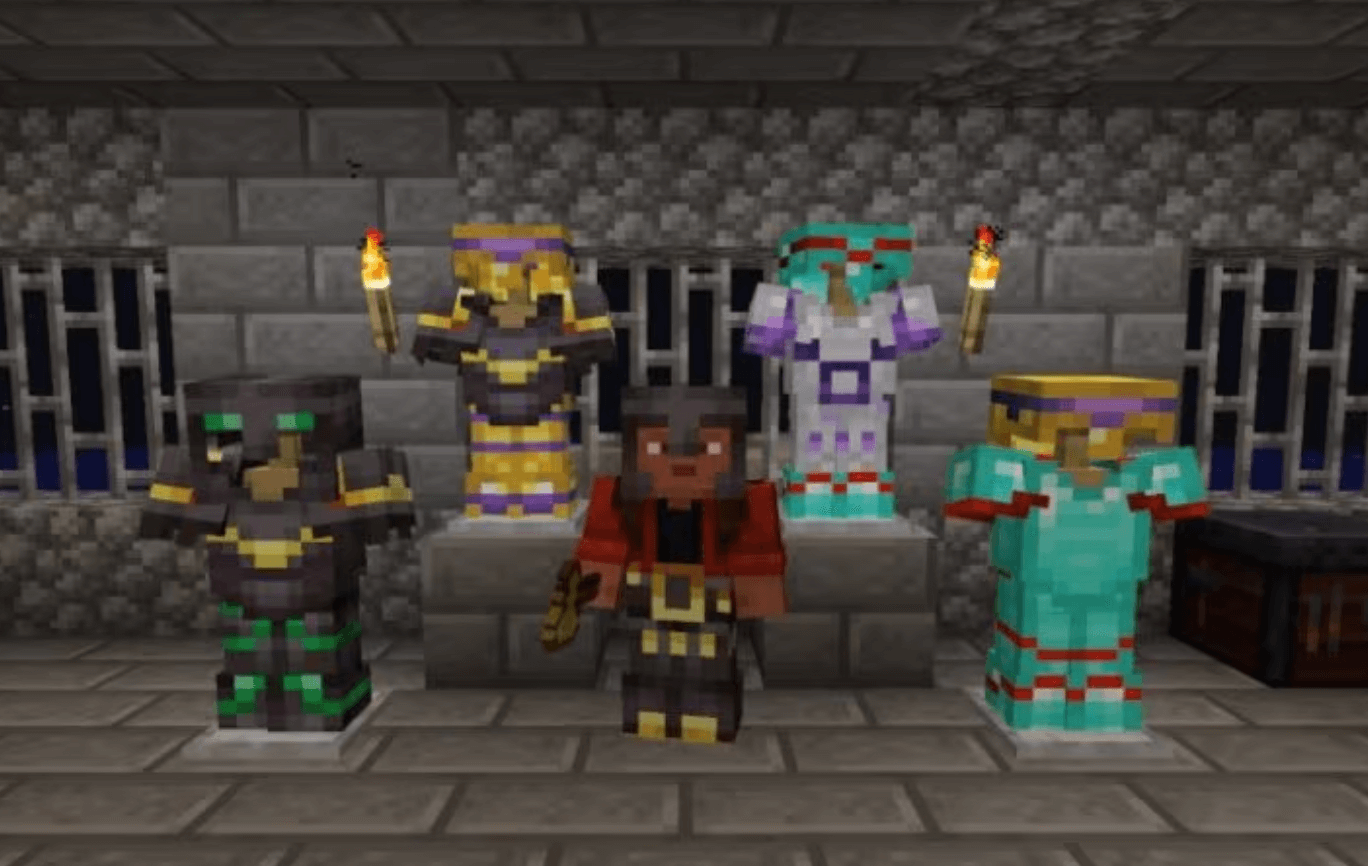
Image courtesy of Minecraft.net
Minecraft Armor Trims
Armor Trims are visual changes that you can apply to your armor using a Smithing Template, and that generally take a look based on what biome or structure you were in when you found the Smithing Template. Here is a list of locations and the trims you can obtain in each:
- Pillager Outpost – Sentry Armor Trim
- Shipwreck – Coast Armor Trim
- Desert Pyramid – Dune Armor Trim
- Jungle Temple – Wild Armor Trim
- Ocean Monument – Tide Armor Trim
- Ancient City – Ward Armor Trim
- Bastion Remnant – Snout Armor Trim
- Woodland Mansion – Vex Armor Trim
- Nether Fortress – Rib Armor Trim
- Trail Ruins – Host Armor Trim
- Trail Ruins – Wayfinder Armor Trim
- Trail Ruins – Raiser Armor Trim
- Trail Ruins – Shaper Armor Trim
- Stronghold – Eye Armor Trim
- End City – Spire Armor Trim
- Ancient City – Silence Armor Trim
Applying Armor Trims
In order to apply the armor trims you’d like, you will need a Smithing Table. When you access a Smithing Table in one of these locations, you’ll notice that there is a new slot in the Smithing Table user interface. First, put in the Smithing Template that you have. Second, place the piece of armor you wish to customize. Lastly, insert a material from the alphabetized list below to select your trim color:
- Amethyst
- Copper
- Diamond
- Emerald
- Gold
- Iron
- Lapis
- Netherite
- Quartz
- Redstone
Once you are finished, you’ll be able to take your trimmed armor from the far right slot and equip it, or alternatively you can display it on an Armor Stand.
Enchantments
enchantments are a means to enhance and empower your gear, from weapons like swords to armor, boots, and more. These mystical upgrades bestow new abilities upon your items, taking their existing attributes to greater heights. With enchantments, you can mine more efficiently, engage in combat with increased prowess, and even enhance your in-game fortune.
The beauty of enchantments lies in their accessibility. You can easily apply enchantments to your items. However, if you prefer enchanted gear without the manual work, there are other ways to acquire them:
- Trading with Villagers: Some villagers offer enchanted items as part of their trades.
- Fishing: Casting your line in oceans and large rivers can yield enchanted treasures.
- Defeating Mobs: Certain mobs like zombies and skeletons may carry enchanted items, which you can obtain upon defeating them.
- Chests: Enchanted items can be discovered in rare chests that spawn in various in-game structures. Your best odds for finding these are in end cities.
- Bartering with Piglins: In the Nether, you can obtain enchanted items through bartering with Piglins.
- Raids (Bedrock Edition): Bedrock players can acquire enchanted items by taking down vindicators and pillagers during raids.
Enchantment Table
The Enchantment Table is a valuable block in Minecraft, employed for bestowing special abilities upon tools, armor, weapons, and raw materials, such as Silk Touch and Punch. To use it, players must expend levels acquired from Experience Orbs. Crafting an enchantment table requires 2 Diamonds, 4 Obsidian, and 1 Book.
To optimize the enchantments, place the table amidst 15 bookshelves to access full level 30 enchantments. On the left side of the interface, you’ll see two slots—the left for your tool and the right for Lapis Lazuli. To enchant, you’ll need the requisite experience levels, 3, 2, or 1 Lapis Lazuli (depending on the enchantment), and it will display the number of levels to be deducted.
The Enchantment Process
In Minecraft’s Survival mode, there are four methods of enchanting items:
- Enchanting Table: Utilize an enchanting table with experience points and lapis lazuli. This method is only applicable to unenchanted items.
- Anvil (Enchanted Book): Combine an enchanted book with an item using an anvil.
- Anvil (Combining Items): Combine two identical items with different enchantments into a single item bearing both enchantments.
- Librarian Villager: Exchange emeralds for enchanted books with a librarian villager, providing an alternative to lapis lazuli and experience points.
Additionally, enchanted items can be obtained by:
- Trading with Villagers: Some villagers offer enchanted items in exchange for emeralds.
- Fishing: There’s a chance of acquiring enchanted items while fishing.
- Mob Drops: When certain mobs (zombie, drowned, husk, piglin, skeleton, stray, wither skeleton, zombified piglin) carrying enchanted items are defeated, there’s an 8.5% chance of obtaining those items.
- Treasure Chests: Enchanted items can be found in treasure chests scattered across various locations in the game world.
- Bartering with Piglins: When trading gold with piglins, there’s a small chance to receive enchanted books or iron boots with the Soul Speed enchantment (ranging from level 1-3).
- Bedrock Edition Raids: In Bedrock Edition, killing pillagers and vindicators during raids can yield enchanted items.
Recommended Enchantments for Armor
Enchantments provide a way to enhance your armor, granting various resistances and abilities to aid your adventures. To enchant items, you’ll need an enchanting table crafted with four obsidian, two diamonds, and one book, along with Lapis Lazuli as a resource. By surrounding the enchanting table with bookshelves, you can access higher-tier enchantments. Here are some of the best armor enchantments:
- Soul Speed: Increases walking speed on soul sand or soil, useful for Nether exploration and mob arenas.
- Aqua Affinity: Enhances underwater mining speed, ideal for underwater cave exploration.
- Depth Strider: Boosts movement speed underwater, perfect for ocean monuments and underwater caves.
- Respiration: Extends underwater breath, invaluable for underwater mining trips and exploration.
- Unbreaking: Increases armor durability, ideal for prolonged use.
- Swift Sneak: Enhances stealth and agility, especially when utilizing level-three upgrades.
- Frost Walker: Instantly freezes water, providing safe traversal and immunity to magma blocks.
- Thorns: Reflects damage to attackers, excellent for crowd control and protection against mobs.
- Projectile Protection: Reduces damage from ranged attacks, useful against mobs with bows.
- Feather Falling: Reduces fall damage, essential for preventing accidents and clumsy falls.
- Protection: Reduces most damage types by up to 16%, valuable for all-around protection.
- Fire Protection: Reduces fire damage and burning time, vital for navigating the Nether and PvP.
- Blast Protection: Mitigates explosion damage and knockback, invaluable against Creepers and TNT.
These enchantments enhance your survivability and efficiency during your Minecraft adventures, providing specialized benefits for various situations and challenges you may encounter.
Efficient Enchantment Strategies
To efficiently gather enchantments in Minecraft, focus on enchanting books to create max-enchanted gear. Enchant books until you have a selection of top-tier enchantments. Then, combine these books with your desired items using an anvil.
Among enchantments, “Mending” stands out as exceptionally valuable, especially for frequently used tools and weapons. Mending repairs equipped gear by absorbing XP bubbles dropped by slain mobs. This effectively maintains your equipment’s durability.
Additionally, “Unbreaking” extends item lifespans, reducing repair frequency. For weapons, prioritize general enhancements like “Sharpness” or “Power” for overall effectiveness. For tools, combine “Mending,” “Unbreaking,” “Efficiency,” and “Fortune” for efficiency and resource gathering.
For armor, consider “Feather Falling” on boots to mitigate fall damage, and max out “Protection” across all pieces for comprehensive defense.
Netherite Armor
Netherite is a remarkable material sourced from the treacherous Nether dimension, primarily serving as an enhancement for diamond gear in Minecraft. When upgraded to Netherite, items gain superior power and durability compared to their diamond counterparts.
Notably, Netherite items possess fire and lava resistance even in their dropped item form. Moreover, Netherite blocks exhibit impressive resilience, surviving nearly all in-game explosions except for the formidable blue wither skulls.
Several blocks and items are associated with Netherite:
- Ancient Debris: Blast-resistant ore found rarely in the Nether, used for crafting and upgrading gear to Netherite.
- Netherite Scrap: Obtained by smelting Ancient Debris, used to craft Netherite Ingots.
- Netherite Ingot: Essential for crafting and upgrading diamond gear to Netherite.
- Netherite Upgrade: A smithing template, found as loot in bastion remnants, used to upgrade diamond gear to Netherite.
- Block of Netherite: The mineral block form of Netherite Ingots, symbolizing ultimate durability.
Advantages Over Diamond Armor
Netherite offers several advantages over diamond armor in Minecraft. To obtain Netherite, players mine Ancient Debris found in the Nether’s lower depths. After refining it into Netherite Scrap using a furnace and combining it with four gold ingots on a crafting table, players get a Netherite ingot.
When incorporated into armor, Netherite provides higher toughness and durability than diamond, along with knockback resistance. Weapons made with Netherite deal more damage than diamond weapons, and Netherite items are impervious to lava, making them invaluable for Nether exploration.
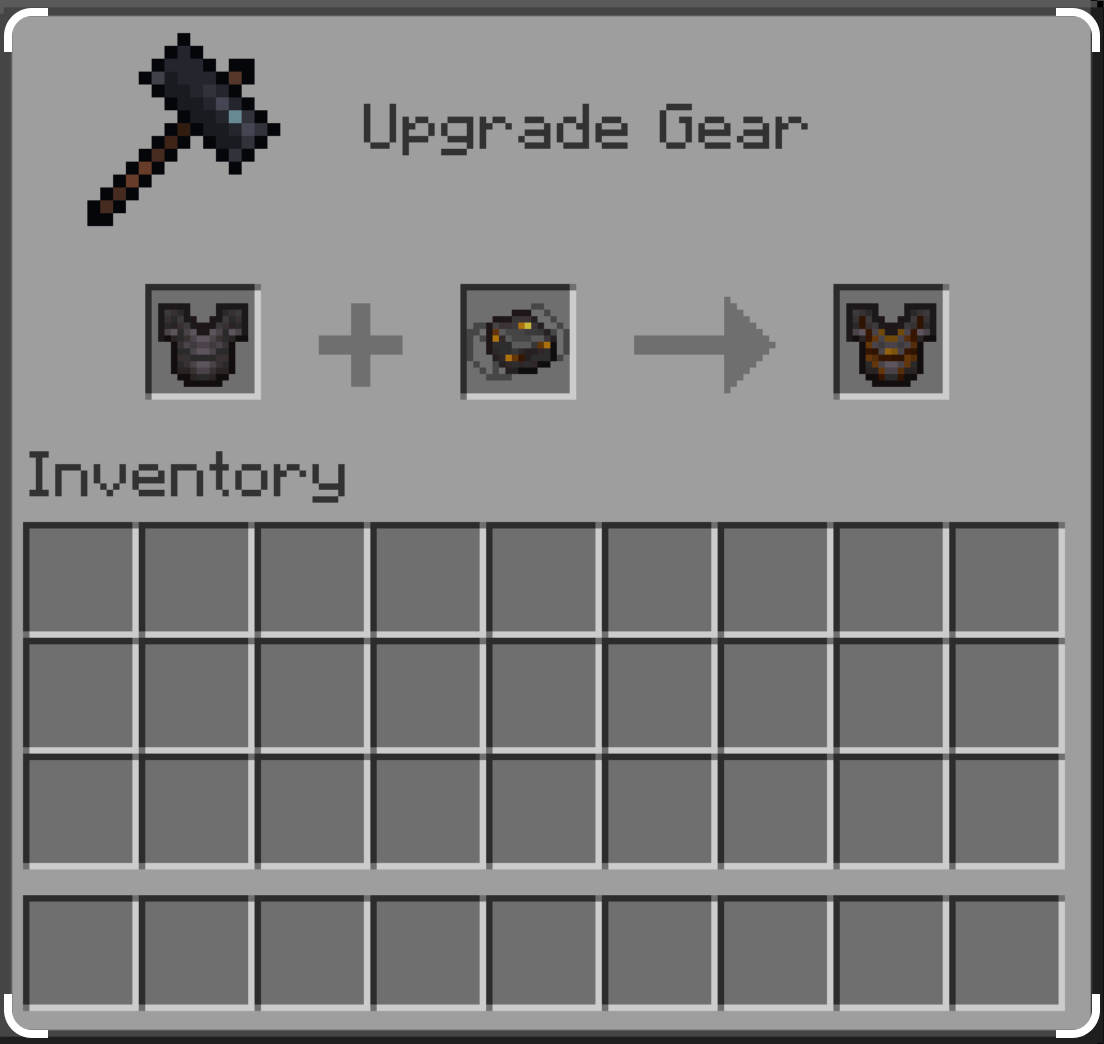
How to Upgrade Diamond Armor to Netherite
To upgrade your Diamond Armor to Netherite Armor in Minecraft, you’ll need to place your Diamond Armor pieces along with a Netherite Ingot on a smithing table. The process involves these steps:
- Craft Diamond armor.
- Smelt Ancient Debris to obtain Netherite Scrap.
- Create Netherite Ingots using Gold Ingots and Netherite Scrap.
- Place your Diamond Armor and a Netherite Ingot on the smithing table for the upgrade.
Perfecting Your End-Game Armor Set
In Minecraft’s end game, the best armor sets consist of full Netherite gear, including Netherite Helmet, Chestplate, Leggings, and Boots. This combination provides maximum protection, durability, and unique perks.
Complement your armor with enchantments like Protection, Unbreaking, Mending, and specific situational ones like Fire Protection or Blast Protection, depending on your adventure. This ensemble ensures you’re well-prepared to tackle the toughest challenges in the game and venture into perilous dimensions like the Nether or the End.
Special Armor
Minecraft offers several unique armor types that cater to various playstyles and environments. Bone armor is an early-game set providing decent protection and made from bones, an easily obtainable resource. Emerald armor, crafted with valuable emeralds, offers a blend of protection and rarity.
Ender armor provides excellent teleportation abilities but sacrifices some protection. Obsidian armor, as durable as its namesake, grants resistance to explosions. Blaze/Fire armor specializes in fire resistance, making it ideal for traversing the fiery Nether.
Additionally, Elytra is a specialized item that grants the power of flight when equipped, revolutionizing exploration. Each of these special armor types enhances your Minecraft experience in unique ways.
Elytra
Elytra is a unique item in Minecraft that allows players to experience controlled flight, even in survival mode. Equipping it in the chestplate armor slot, you can leap from heights and activate it by pressing the “jump” button while descending.
The Elytra’s wings will unfold, granting you control over your descent. Adjust your pitch to control your speed, but be cautious of sharp turns and obstacles to avoid mishaps during your airborne adventures.
Acquiring the Elytra
Elytra in Minecraft can only be found in End cities, specifically in the treasure room of an End ship. However, locating one can be a challenging task, as they are guarded by shulkers. Once obtained, Elytra can become damaged over time.
To repair them, players can either find another Elytra in the End and combine the two using an anvil or use phantom membranes, which also preserve any enchantments on the Elytra. Each membrane restores about 25% durability.
To acquire Elytra:
- Use the End portal in a stronghold to reach the End dimension.
- Defeat the Ender dragon if not already done.
- Access the End gateway portal, often requiring an Ender pearl to enter.
- Explore End islands until you find an End city with an adjacent End ship.
- Inside the End ship, locate the Elytra in an item frame and break the frame to obtain it.
Elytra Flying Mechanics and Control
Flying with Elytra involves pressing the jump key while falling, causing the Elytra to open up like beetle wings. Players can control their flight by adjusting their view for turning or pitch changes. Altitude changes affect speed, with descending increasing it and ascending reducing it.
Firework rockets can boost speed, but sharp direction changes lead to speed loss. Colliding with surfaces at high speeds damages the player and armor. A safe long-distance glide can be achieved by aiming at the horizon.
In Creative mode or with the “mayfly” ability, holding the jump key allows players to fly upward, while a double press enables free movement. Flight can be halted by pressing the jump key.
Elytra maintain a minimum speed of around 7.2 m/s and accelerate back up if speed drops to zero. Drag increases with speed, simulating real-world aircraft behavior. To glide between cliffs, aiming slightly above the horizon is advised.
Sharp turns result in significant speed loss, while gentle movements have minimal effects. Hairpin turns can ensure safe, high-speed landings and precise landings on small targets.
For the lowest rate of altitude loss (about 1.5 m/s), glide at the altitude cap with a slight upward pitch (12° or 15°). To maximize glide ratio and cover the most distance from altitude, aim directly at the horizon, achieving a ratio of about 9.47 to 1.
Elytra – Use in Combat and Exploration
Elytra in Minecraft are a versatile tool, not limited to just flying. They provide unique advantages in combat and exploration. In combat, players can swoop down on enemies or evade them with nimble maneuvers, making it useful for both offense and defense.
For exploration, Elytra offers a quick means of traversing vast landscapes, locating structures, or escaping danger. Their versatility makes them an invaluable asset for players looking to conquer the Minecraft world efficiently and with style.
Turtle Shell
Turtle shells offer an interesting underwater advantage. When worn in the helmet slot and the player is out of water or in a bubble column, they provide the “water breathing” status effect. This effect counts down only when the player is submerged. The shells also offer two armor points, similar to iron, gold, and chain helmets.
They boast greater durability than regular iron helmets, enduring nearly twice as many hits before breaking. Additionally, turtle shells can be used as brewing ingredients to create a Potion of the Turtle Master, granting Resistance III but also Slowness IV.
Turtle Shell – Unique Properties and Crafting
When worn, a turtle shell in Minecraft provides 2 armor points and 10 seconds of Water Breathing, resetting upon surfacing. Additionally, turtle shells can be used to brew a Potion of the Turtle Master, offering Resistance IV and Slowness IV.
Crafting a turtle shell requires collecting 5 scutes, obtainable by breeding and protecting turtles. These shells, like other helmets, can be repaired and enchanted using scutes on an anvil and enchantment table. An improved Potion of the Turtle Master can grant Resistance VI, making the player nearly invincible.
Underwater Breathing Tactics
Turtle shells provide extended underwater breathing capabilities in Minecraft. Equipping them in the helmet slot grants the player 2 armor points and 10 seconds of Water Breathing, resetting upon surfacing.
These shells also serve as a key ingredient in brewing a Potion of the Turtle Master, offering unique tactical advantages for underwater exploration and combat.
Combining with Other Armor Sets
Turtle armor in Terraria is a formidable Hardmode set obtainable after defeating all three mechanical bosses. Comprising the Turtle Helmet, Turtle Scale Mail, and Turtle Leggings, this set is renowned for its unique Thorns effect. When wearing the full set, it significantly amplifies the Thorns effect, reflecting double the damage from melee attacks back onto the attacker.
In addition to the Thorns bonus, the Turtle armor set provides various benefits:
- A 14% increase in melee damage.
- A 12% boost to melee critical strike chance.
- A substantial +65 defense, enhancing survivability.
- An impressive +750 aggro, drawing enemy attention.
- A 15% reduction in damage taken.
Equipping the full set of Turtle armor also results in a distinctive appearance feature: a turtle shell appears on the player’s back, much like certain backpack items in the game.
To craft Turtle armor, players need a total of 54 Chlorophyte Bars, which corresponds to 270 Chlorophyte Ore or 324 Chlorophyte Ore in some versions, along with 3 Turtle Shells.
While the passive Thorns effect is excellent for dealing with weak enemies reliant on contact damage, it loses effectiveness against Hardmode bosses and ranged attacks. Turtle armor excels in multiplayer as a support set, drawing enemy aggro effectively. When paired with the Paladin’s Shield or its upgraded versions, it enhances survivability for both the player and their teammates.
For those desiring a more offensive approach, combining Turtle Scale Mail with a Chlorophyte Mask or Hallowed Mask and Squire’s Greaves creates a potent melee set. However, this setup sacrifices the 15% damage reduction and the Thorns effect present in the full Turtle armor.
Frequently Asked Questions
Embark on a quest through the blocky realms of Minecraft! To aid you on your journey, we’ve compiled answers to frequently asked questions about this iconic sandbox game.
How important are weapons and armor in Minecraft?
Weapons and armor are crucial in Minecraft as they provide protection from hostile mobs and enhance your ability to survive. Diamond weapons deal more damage, while armor sets, like Diamond, offer better protection. They’re essential for tackling challenges, exploring dangerous areas, and defeating powerful mobs and bosses.
What’s the best weapon for beginners?
For beginners, a simple weapon like the iron sword is a good choice. It’s readily available, offers decent damage, and is easy to craft. As you progress, consider upgrading to diamond weapons for more power and efficiency in combat.
Should I prioritize armor or weapons first?
Prioritizing weapons over armor is advisable. While armor is essential for protection, having powerful weapons helps you defeat enemies more efficiently and effectively. It’s easier to make up for lower defense with better armor later, but lacking damage can make battles much harder.
How do I enchant my gear?
Enchanting gear in Minecraft is straightforward. Just place your tool in the left slot of the enchanting table and add lapis lazuli to the right slot. Three enchantment choices will appear, each costing 1 to 3 lapis lazuli and 1 to 3 player levels earned from XP.
What are the best enchantments for armor and weapons?
the best enchantments for armor and weapons can greatly enhance your gameplay. For armor, essential enchantments include:
- Soul Speed
- Aqua Affinity
- Depth Strider
- Respiration
- Unbreaking
- Swift Sneak
- Frost Walker
- Thorns
- Projectile Protection
- Feather Falling
- Protection
- Fire Protection
- Blast Protection
To enchant your gear, you’ll need an enchanting table crafted with obsidian, diamonds, and a book.
How can I obtain netherite armor?
To obtain Netherite armor in Minecraft, you’ll need Netherite Ingots, which require a Diamond Armor Set (boots, chest plate, helmet, and leggings), Upgrade Smithing Templates, a Smithing Table, and optionally, Blocks of Netherrack and Diamonds.
Combine these components using the smithing table to upgrade your diamond armor into formidable Netherite armor for increased durability and strength.
What’s the best combat strategy for the Nether?
The best combat strategy for the Nether in Minecraft involves creating a secure hub around your Nether portal to prevent sudden dangers upon entry. Spawn-proof the hub area using torches, slabs, or carpets to avoid mob spawns.
Prioritize stocking up on food and equip yourself with strong armor and weapons, enhancing them for better defenses before entering the Nether or End realms. Leave unnecessary items behind to minimize risk.
How can I effectively use ranged weapons in Minecraft?
Effectively using ranged weapons in Minecraft involves maintaining distance from mobs to avoid taking damage. The Punch enchantment enhances ranged weapon knockback, with two tiers available, each providing a noticeable difference in impact. Use this enchantment strategically to keep mobs at bay and increase your effectiveness with ranged attacks.
Are there any special combat tactics for the End dimension?
Combat in the End dimension, particularly against the formidable Ender Dragon, remains a significant challenge in Minecraft. To prepare for this ultimate battle, consider the following tactics:
- Build An Obsidian Base: Construct a secure obsidian base to shield yourself from Endermen while engaging the dragon.
- Opt For Bow & Arrow Combat: Ranged combat with a powerful bow and plenty of arrows is a safer approach to damaging the dragon.
- Collect Beds: Beds can serve as respawn points if you die in the End, allowing you to rejoin the fight quickly.
- Bring Ender Pearls: Ender pearls help you teleport away from danger when necessary.
- Wear A Carved Pumpkin: Prevent Endermen from becoming hostile by wearing a carved pumpkin on your head.
- Bring Water Buckets: Water buckets can be used to break your fall when the dragon launches you into the air, preventing fall damage.
These tactics, when employed strategically, can improve your chances of defeating the Ender Dragon and surviving the End dimension.
What are the most unique weapons and armor in Minecraft?
Minecraft boasts some unique weapons and armor, each with distinctive features and abilities. Notable ones include:
- Diamond Pickaxe: Exceptionally efficient for mining.
- Eternal Knife: A rare, powerful melee weapon.
- Fangs Of Frost: A frosty, cold-inflicting weapon.
- Diamond Sword: Known for its iconic and versatile design.
- Hunter’s Promise: A potent crossbow.
- Nameless Blade: A mystical, enchanted blade.
- Spider Armor: Armor set with enhanced abilities.
- Sun’s Grace: A radiant and protective set of armor.
- Grave Bane: A weapon with the power to defeat undead foes.
- Cave Crawler Armor: Armor designed for subterranean exploration.
Can I customize my armor’s appearance?
Armor trims offer a creative way to customize your gear, infusing it with your unique style and showcasing your journeys in the Overworld. You can select from 11 diverse patterns and the option to dye them in ten vibrant colors.
How do I repair damaged weapons and armor?
To repair damaged weapons and armor, place the item in the first slot of the anvil. In the second slot, add the material used to craft the item. For instance, to fix an Iron Axe, place it in the first slot and an iron ingot in the second.
This method is more cost-effective than crafting a new item. Note that using an anvil may add prior work penalties, which can be removed by repairing on a crafting grid.
Conclusion
In the vast pixelated realms of Minecraft, players develop crucial problem-solving skills, cultivate creativity, and master resource management—all of which are essential life skills. Beyond the realm of gaming, these skills translate seamlessly into the real world, fostering critical thinking and adaptability.
Minecraft coding offers an exceptional avenue for kids to dive into the world of programming, enhancing their logical reasoning and technical acumen. At CodaKid, we recognize the immense potential of Minecraft coding, offering courses that blend fun and learning.
Unlock the benefits of Minecraft coding for kids and embark on a journey that merges entertainment with education. Join us to explore the endless possibilities today!
Modded Weapons video















